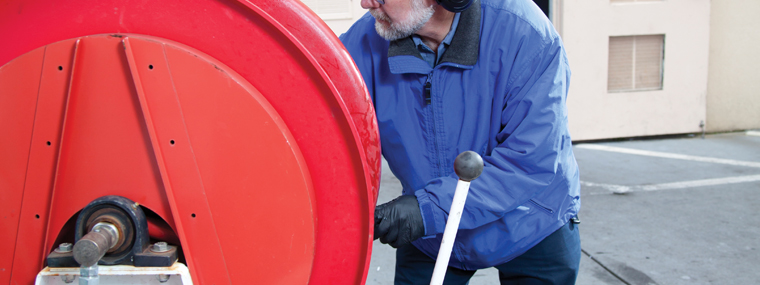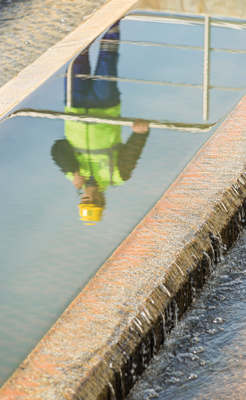
The Need for Hydro Jetting
by Diane M. Calabrese / Published September 2023

Clogs are one of life’s obstacles we don’t like to think about. From clogged pipes to clogged colons, the word clog signals trouble. Obstructions in tubular or narrow pathways impede (even stop) movement. Something must be done.
Using force to push a metal snake/cable down a sewer line is one way to dislodge a blockage. Adding chemicals is another. But in the quest to minimize damage to structural integrity and the environment, hydro jetting has developed as an effective, popular option.
“Sewer jetting is a great innovation that helps to keep our wastewater flowing,” says Ryan Lindaman, industrial sales manager at Hydra-Flex Inc. in Savage, MN. “Utilizing the combination of the correct jetter and nozzle can help to keep residential and commercial lines clean from blockages like fats, oils, and grease (FOG) as well as scale, roots, and ice.”
Anyone who lives in a tree-rich area with an aging sewer system and not-so-young houses can attest to the comings and goings of plumbers who advertise hydro jetting on their trucks as one of many services. The embrace of the hydro jetting technique by plumbers mirrors what Lindaman observes.
“Sewer jetting has been our company’s fastest-growing category. As more plumbers adopt the hydro jetting/sewer jetting technology, there is a greater need for our nozzles, like the Reaper™,” says Lindaman. (That trademarked nozzle can be seen in action—taking on ice and frozen debris—in a video at the company’s website.)
The exemplary nozzle that Lindaman cites blasts up to 5000 psi as it cuts and clears (harvests) the undesirable material that has accumulated in the aperture and/or along the wall of a sewer. The placement and angle of its jets—front and rear—are carefully designed to do the most, the fastest, and with the least water.
The chunks of sewer and water lines that plumbers sometimes remove and incidentally showcase as they do their after-project cleanup can be quite impressive. Even if there had been a path through the line, the walls may be thick with muck. Again, these are things most of us don’t like to think about, but that we certainly know.
“Mitigating damage to the infrastructure is one of the key benefits of hydro jetting versus alternative processes like ‘snaking’ or using manual cutters,” says Lindaman. “Hydro jetting also allows you to flush debris down the line while completing the job.”
It’s A Little Like That…
Using sewer jetting and hydro jetting as interchangeable terms makes sense in the context of sewers, but trying to assign a definition to hydro jetting that covers all permutations and contexts is much like separating a pony car from a muscle car (and so many other terms that overlap).
Not everyone applied the term muscle car strictly to vehicles with V8 engines and rear-wheel drive, so right from the start there was loose terminology. Car enthusiasts spend considerable time debating the line between muscle car and pony car. Some of the debate is strenuous.
A similar debate arises with hydro jetting, but it’s a low-key one. For instance, some tools with very high psi—up to 35,000 psi (and even beyond)—are labeled hydro-jetting equipment. In medical settings, hydro jetting labels a technique that may use pressures well below 1000 psi.
Moreover, though hydro jetting usually signals there is a conduit of some kind to be entered by equipment (not operators), the shape of the conduit is not always tubular. For example, trash chutes may be cleaned by a contractor who uses what he or she calls a hydro-jetting tool.
Hydro-jetting tools generally go where their operators do not. That distinguishes them from hydro-blasting tools that may be in proximity to an operator when the outside of a structure—possibly a pipe—is the target.
Fragmenting solids in a sewer pipe may not have the allure of fragmenting gold in a mine vein, but the two are related. The WaterJet Technology Association (WJTA.org) traces the long root of waterjetting to the 1850s and hydraulic mining of gold.
Of course, the early tools depended on enormous amounts of water, while the jetters that developed over 170-plus years minimize the use of water. In connection to pipes, however, a force to push a bigger volume of water through in a unit of time is a manual method still used to clear toilet blockages. It’s the force supplied by a homeowner manipulating a plunger.
Someday terminology may be as precise as bar and QR (quick response) codes. Now, it is not.
Practice, Not Theory
Plumbing contractors that offer hydro-jetting services often suggest a preventive maintenance program for sewer lines. Residential and commercial building owners could gain with such programs since they would presumably have to make fewer emergency calls.
Yet some emergency calls such as ice in the line cannot be prevented by hydro jetting. The big advantage of a preventive maintenance program is that it reduces the risk of a sewer backup, which can do extensive property damage. Another advantage is that the plumbing keeps working, so there is no displacement of business or family.
There are still plenty of cast-iron water and sewer pipes in the oldest parts of the nation (Mid-Atlantic to New England, particularly). Over time, the iron scales and flakes break away. It’s never a surprise to see some flakes coming out of the tap, but local water companies try to prevent such happenings by hydro jetting the lines at regular intervals. Tackling one pipe segment at a time, the companies both clean walls of pipe and push the dislodged material downstream to another point where it is allowed to exit (flushed out) for collection.
Nozzles in hydro jetting are matched to the objective. For example, rotating nozzles produce a spray that cleans the pipe wall after any blockage has been cleared. Point or fan-shaped spray-capable nozzles would be used to break up the blockage.
Iron flakes on pipe walls are very different from tree roots coursing through a pipe, but hydro jetting can dispatch both. (Exceptions do happen. We have seen sewer pipes removed where the diameter of a tree root had grown to occupy the diameter of the pipe, occluding it completely.)
Many people have the idea that sewers and waterlines are seamless structures with no breaks or entryways for plant roots. Not so. There’s quite a lot going on beneath our feet; the idea is not to encourage roots that find a way into a pipe to remain and grow larger. Routine hydro jetting can help.
Grease and oil buildup in pipes does not just lead to clogs. It also beckons rats, which don’t depend on crevices in pipes to enter but just get in boldly through sewer openings and/or sinks and toilets in decrepit structures. The priority of any home or building owner should be to send as little oil and grease into a drain as possible. The corollary to the priority should be preventive maintenance, perhaps through hydro jetting.
The effectiveness of hydro jetting in sewers and pipes is documented every day. From the perspective of a contractor, not only is hydro jetting safer than mechanical or chemical tools, but also it reduces the complexity of cleanup. Cleaning a snaking tool is not a pleasant or speedy task.
Hydro jetting also gets high marks for being thorough. Suppose there is a complete blockage in a sewer. Pushing a snake—cable—through will open a pathway, a pathway equivalent to the diameter of the snake. But some of whatever is caked on the interior wall of the pipe will remain, only to continue to accrete.
Given the condition of pipes nearing the end of service life, contractors using hydro jetting as a tool must be able to assess whether the pipe can withstand the process. Sometimes it’s not just a clean out that a pipe requires. It’s a replacement.
Just how much debris can be in a sewer line? The term “fatberg” is used to describe a particularly noticeable blockage. Records of fatbergs are kept, some of which seem too astounding to be true, but record-making varieties are measured in hundreds of feet and tons.
Distasteful as fatbergs are, they do not surprise. The indiscriminate use of sink drains and toilets for disposal of waste that should go into trash receptacles gets the process started.
Prevention—doing everything possible to practice good hygiene in disposal—is the best option. But when hydro jetting is needed to set things right, it’s a good method for cleaning sewers and pipes.
Then, there’s another type of prevention, which takes us to one use for hydro jets in medicine. Instead of pushing a device through a colon to accomplish a colonoscopy, a prototype method adapts a hydro jetting method. The lumen of the colon is filled with water and a camera, and LEDs are moved through the water with hydro jets providing the propulsion.
Hydro jetting serves in many settings. That’s the point of the preceding paragraph. The lexicon will continue to undergo modification, and in time hydro jetting used to clear infrastructure will never be confused with hydro jets in a medical application.
Clarity of meaning will not detract from the word “clog,” though. Clog will continue to convey an undesirable/undesired event.






